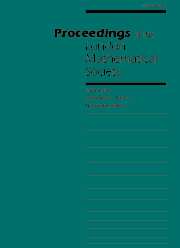Crossref Citations
This article has been cited by the following publications. This list is generated based on data provided by
Crossref.
Quick, Martyn
2004.
Probabilistic Generation of Wreath Products of Non-abelian Finite Simple Groups.
Communications in Algebra,
Vol. 32,
Issue. 12,
p.
4753.
Guralnick, Robert M.
and
Robinson, Geoffrey R.
2006.
On the commuting probability in finite groups.
Journal of Algebra,
Vol. 300,
Issue. 2,
p.
509.
Pak, Igor
2012.
Testing commutativity of a group and the power of randomization.
LMS Journal of Computation and Mathematics,
Vol. 15,
Issue. ,
p.
38.
VDOVIN, E. P.
2012.
ON THE BASE SIZE OF A TRANSITIVE GROUP WITH SOLVABLE POINT STABILIZER.
Journal of Algebra and Its Applications,
Vol. 11,
Issue. 01,
p.
1250015.
Guest, Simon
and
Levy, Dan
2013.
A Remark on Two Solvability Criteria of Thompson.
Communications in Algebra,
Vol. 41,
Issue. 1,
p.
309.
GRUNEWALD, FRITZ
KUNYAVSKII, BORIS
and
PLOTKIN, EUGENE
2013.
CHARACTERIZATION OF SOLVABLE GROUPS AND SOLVABLE RADICAL.
International Journal of Algebra and Computation,
Vol. 23,
Issue. 05,
p.
1011.
Guest, Simon
and
Levy, Dan
2014.
Criteria for solvable radical membership via p-elements.
Journal of Algebra,
Vol. 415,
Issue. ,
p.
88.
JAFARIAN AMIRI, S. M.
MADADI, H.
and
ROSTAMI, H.
2016.
ON THE PROBABILITY OF GENERATING NILPOTENT SUBGROUPS IN A FINITE GROUP.
Bulletin of the Australian Mathematical Society,
Vol. 93,
Issue. 3,
p.
447.
Lucchini, Andrea
2020.
Applying the Kövári-Sós-Turán theorem to a question in group theory.
Communications in Algebra,
Vol. 48,
Issue. 11,
p.
4966.
BHOWAL, Parthajit
NONGSİANG, Deiborlang
and
NATH, Rajat
2020.
Solvable graphs of finite groups.
Hacettepe Journal of Mathematics and Statistics,
Vol. 49,
Issue. 6,
p.
1955.
Wei, Huaquan
Gu, Huilong
Li, Jiao
and
Yang, Liying
2021.
On the nilpotent probability and supersolvability of finite groups.
Monatshefte für Mathematik,
Vol. 194,
Issue. 2,
p.
371.
Bhowal, Parthajit
Nongsiang, Deiborlang
and
Nath, Rajat Kanti
2022.
Non-Solvable Graphs of Groups.
Bulletin of the Malaysian Mathematical Sciences Society,
Vol. 45,
Issue. 3,
p.
1255.
Gheri, Pietro
2022.
Subnormalizers and solvability in finite groups.
Journal of Algebra,
Vol. 608,
Issue. ,
p.
1.
Atabekyan, V. S.
and
Bayramyan, A. A.
2024.
Probabilistic Identities in n-Torsion Groups.
Journal of Contemporary Mathematical Analysis (Armenian Academy of Sciences),
Vol. 59,
Issue. 6,
p.
455.
Aivazidis, Stefanos
Loukaki, Maria
and
Müller, Thomas W.
2024.
On the common transversal probability.
Journal of Group Theory,
Akbari, Banafsheh
Chuharski, Jake
Sharan, Vismay
and
Slonim, Zachary
2025.
Characterization of solubilizers of elements in minimal simple groups.
Communications in Algebra,
Vol. 53,
Issue. 5,
p.
1995.
Levin, Ilan
2025.
How associative can a non-associative Moufang loop be?.
Communications in Algebra,
p.
1.
Wei, Huaquan
Hou, Xuanyou
Sun, Changman
Diao, Xixi
Wu, Hui
and
Yang, Liying
2025.
The Nilpotent Probability of Finite Groups.
Acta Mathematica Sinica, English Series,
Vol. 41,
Issue. 4,
p.
1238.
Tong-Viet, Hung P.
2025.
Variations on the Thompson theorem.
Journal of Algebra,
Vol. 668,
Issue. ,
p.
46.

